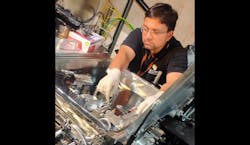Extreme electromagnetic fields are created when electrons within materials vibrate and bounce at high speeds, and Aakash Sahai, an assistant professor of electrical engineering at the University of Colorado Denver, recently came up with a way to make it happen within the lab for the first time (see video).
His inspiration stems from a dire need for innovative tools to take the scientific reach of mankind well beyond what’s possible with current technologies. “Existing techniques require building large facilities—tens of miles of accelerators—costing billions of dollars while also being confined within the reach of small scientific communities,” says Sahai. “This threatens to severely limit the future generation of scientific explorations.”
Creating fields strong enough for advanced experiments typically requires huge, expensive facilities like the Large Hadron Collider at CERN. Sahai’s innovation may eventually enable shrinking massive colliders to a chip—which is astounding—and allow scientists to explore physics, chemistry, and medicine in an entirely new way.
Bit of background
There are three key concepts involved in Sahai’s work: Materials, a quantum gas, and lasers.
Here’s the key takeaway about materials: After many decades of observational data in accelerator science where materials are considered one-shot or dispensable, “our materials can withstand interactions with high-intensity particle beams due to unconventional heat transport owed to quantum effects,” says Sahai.
Quantum: The conduction electron gas present within all conductive media “is a quantum gas because all electrons occupy discrete quantum states,” Sahai explains. “Our work is the first to conceptualize and analyze nonperturbative excitations of this quantum gas, which are referred to as extreme plasmons.”
Lasers: Electromagnetic focusing fields of extreme plasmons excited within quantum materials by a particle beam “can oscillate the tail of the beam at such short wavelengths that the oscillating beam particles emit gamma-ray photons, which can be coherent,” Sahai adds. “This is in some sense similar to an x-ray free-electron laser (FEL) like the one located at the Linac Coherent Light Source (LCLS).”
Oscillating ultradense quantum electron gas
When the ultradense quantum electron gas inherent within structured conductive materials is nonperturbatively excited, the electrons—think one billion within a microcube—of the gas greatly compress into exceedingly small volumes.
“This results in large electromagnetic energy density that’s measured as an electric field,” says Sahai. “In terms of classical physics, simple application of Gauss’s law tells us that a large charge density results in a correspondingly large electric field.”
Sahai’s material manages the heat flow generated by the oscillation and keeps the sample intact and stable, thanks to an emergent phenomena underlying extreme plasmons referred to as relativistic ballistic transport—it allows collisionless heat dissipation and preserves the material structure. It’s why the material has the potential to one day shrink huge colliders like CERN onto a chip.
Manipulating high energy flows “while preserving the underlying structure of the material is the breakthrough,” says Kalyan Tirumalasetty, a graduate student working with Sahai.
Fundamental physics ahead
Extreme electromagnetic fields can be used to build machines needed for fundamental physics. Sahai says there are currently three decadal objectives: Develop a new particle accelerator technology based on extreme plasmons to probe unknowns like dark matter and dark energy, demonstrate nanobunching or nanomodulation of ultra-intense electron beam for coherent gamma-ray production, and nanofocusing of the ultra-intense electron beam to drive polarization or opening of the vacuum.
In the future, increasing the accessible field will enable initial tests of string theoretical predictions.
Most surprising aspect of this work? “Several well-established accelerator physicists from reputed labs and universities across the world strongly held the view that this quantum tool is merely a theoretical exercise,” says Sahai. “When we first saw preliminary signatures indicating the veracity of our theoretical predictions, the feeling it gave us was well and truly beyond words.”
The researchers do still face numerous challenges because “the current material samples in our prototyping experiments are like the first transistors made at Bell Labs or the first chips made at Texas Instruments,” Sahai points out. “Instead of using off-the-shelf elements that don’t allow precise control over the parameters, custom-designed materials—both in structures as well as microscopic properties—allow us to realize the full potential.”
They’re currently seeking funding to improve their plasmonic chip build and its tunability.
“Our ongoing prototyping efforts—as part of the E339 experiment at SLAC National Lab—are aimed at finding the exact details of the experimental data obtained so far to not only increase the accessible parameters but to more deeply understand the underlying physics, which has not been explored before,” says Sahai. “Hopefully, with this work being funded, we’ll be able to build high-quality quantum materials to extract the exquisite details and scaling laws for the benefit of the future generations as well as for revolutionizing the reach of imminent scientific exploration.”
FURTHER READING
A. A. Sahai, Adv. Quantum Technol. (May 19, 2025); https://doi.org/10.1002/qute.202500037.
About the Author
Sally Cole Johnson
Editor in Chief
Sally Cole Johnson, Laser Focus World’s editor in chief, is a science and technology journalist who specializes in physics and semiconductors.

